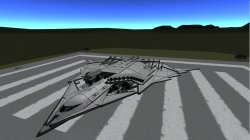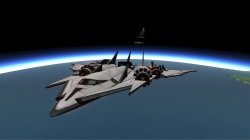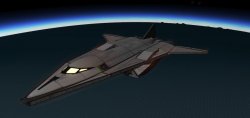Kerbal Space Program and can be also found on Steam for Mac and PC
Pulled from Steam Games Thread...
As you can see I started a new thread specifically on Kerbal Space Program as a search did not reveal an existing thread and I did not want to overload the Steam Games thread. I'm also working on a Quick and Dirty Guide for my own sake. This is a game that actually requires some study.
Update: In an online guide, someone said you could warp time 4X? Maybe it depends what mode you are playing?
I think that they need to allow a time warp during burns. I for one don't really want to spend an hour during a burn.
Pulled from Steam Games Thread...
Fuel: the amount of fuel is irrelevant--the delta-V is all that matters. An ion probe and a huge transport may have the same delta-V, but an inordinately different amount of fuel. That same probe has a high Isp, and therefore a huge change in velocity. However, its TWR (thrust to weight ratio) is pathetic and you'll be tearing your hair out at hour-long burns. The LV-N is usually what people use for interplanetary missions, as it has a high Isp and acceptable TWR.
Trajectories: short answer: math. Long answer: lots of math. In all seriousness, the navball is your friend here, and really all you have to do is match the inclination of your target and then burn until you're caught by the gravity of wherever you want to go--as KSP does not use n-body physics, but rather patched conics. Certainly simplifies spaceflight...
A good many people enjoy Scott Manley's videos on YouTube. Personally I've never watched his tutorial vids, but his Interstellar Quest and some others are great.
If you don't mind using mods, MechJeb is a great autopilot that will fly your launches and spacecraft for you. Some people consider it cheating, but they're the types that enjoy flying everything. It does much more than that, such as tell you the weight of your spacecraft and how much delta-V you have, but if you don't want the autopilot and just the vessel information, Kerbal Engineer is just the ticket.
As for the amount of delta-V you need to get to other planets, the KSP wiki has a handy reference list on the page for Kerbin. However, I'd take those numbers with a grain of salt, as they assume completely nominal trajectories, which you will rarely have. In my experience you can expect those numbers to double, if not more.
There's also a handy-dandy delta-V map, again on the KSP wiki, but as I said before: take the numbers with a grain of salt.
You may be interested in these articles on Wikipedia:
If there are any other questions you have, feel free to shoot me a PM, email, whatever.
Thank you!! Very helpful. One of the major issues I have with Elite Dangerous is hand flying space craft due to lack of an autopilot and minimal use of computers. It's just unrealistic and while dogfighting is fun, I am constantly reminded of how unrealistic this is. Therefore, I have no problem in KSP with an autopilot mod, which is how real space rockets are flown. There are times that manual flying might be required with a breakdown, but the notion of cheating is stupid. Regarding long burns, can't you just time warp through them? I'll search youtube for KSP content. Thanks again!
Nope, not unless you're using the ion engine. Otherwise, you have to sit through every painful minute.
As you can see I started a new thread specifically on Kerbal Space Program as a search did not reveal an existing thread and I did not want to overload the Steam Games thread. I'm also working on a Quick and Dirty Guide for my own sake. This is a game that actually requires some study.
Update: In an online guide, someone said you could warp time 4X? Maybe it depends what mode you are playing?
I think that they need to allow a time warp during burns. I for one don't really want to spend an hour during a burn.
Last edited:




